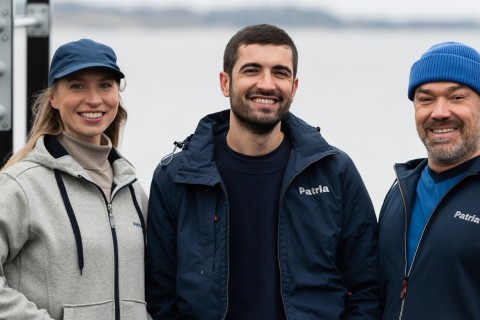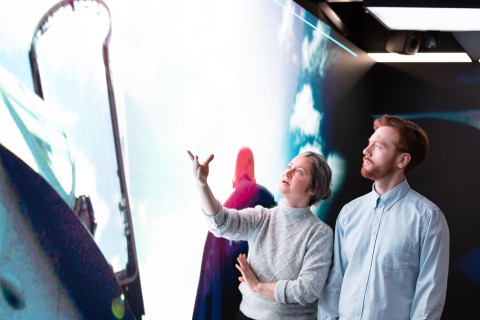

On the threshold of new technology: Aircraft components as a 3D printout
13.4.2018
5 January 2018 marked a small, but important, milestone in the history of aircraft maintenance. On that day, Finland's first 3D-printed jet engine part made its maiden flight in a F/A-18 Hornet fighter. 3D printing will be an important part of Patria's repair development in the future.
The part is made of a nickel-based, highly heat and corrosion-resistant Inconel 625 superalloy, and was designed by Patria in compliance with MDOA approval. MDOA approval refers to Military Design Organisation Approval in accordance with European Military Aviation Requirements (EMARs) and granted by the Finnish Military Aviation Authority (FMAA).
This was no one-off – the parts are still installed in the aircraft.
Detail.
Threefold benefit
Patria's Aviation unit is exploring new methods of manufacturing and repairing aircraft parts. The part that made its maiden flight in January is just one stage in this work. Work on engines is being done at Linnavuori Engines Unit in Nokia, close to Tampere, in particular. There, the jet engines of Hornets, NH90 helicopters and Hawks are maintained in a cave. – A great deal of repair development, for which 3D printing is highly suitable, has been done at Linnavuori. We start by considering how we can repair a part, rather than buying an expensive, entirely new component," says Ville Salminen, Engineering Manager.
Ville Salminen
In addition to cost control, repair work is based on the need to shorten the so-called turnaround times of the engines. In other words, the goal is to shorten the time during which the engine is unused. The speed with which spare parts are available is an important factor in this. – In the future, a large proportion of spare parts – or their components – may be replaced by 3D printouts. Development work on the part in question has been done over the last two years, with the broader goal of studying the manufacturing process of 3D-printed parts from drawing board to actual use. Another background factor is raising usability, which in simple terms refers to the desire to make better and more durable parts. Around two-dozen Patria employees have been involved in the 3D project.
The next industrial revolution?
Patria has participated in two 3D projects: one being Patria's own Tekes-funded project, and the other the Digital Spare Parts or DIVA project, led by Aalto and VTT, which ended in 2017. DIVA project involved a concept whereby spare parts and the associated information are stored and transferred digitally; where needed, part of the manufacturing is done by 3D printing.
It is thought that 3D printing has the potential to revolutionise entire industrial sectors. Creating parts with 3D accelerates the entire production process, from the customer's need to the finished product. Maintaining large stocks could, in theory, become a thing of the past when spare parts can be printed as needed. Waste will also be reduced when production can be scaled according to need. In principle, entire production areas could move from China to Finland, for example, as 3D printing requires very little human input. Printing costs the same, regardless of the location.
Risto-Pekka Niemi
– Some refer to this as the fourth industrial revolution; on the other hand, expectations have become more realistic than, say, a couple of years ago. It was then generally believed that 3D printing would kill off the entire engineering industry. We and others now see 3D printing having a clear market share, but traditional methods will also be continued, says Risto-Pekka Niemi, a NDT Engineer who served as Project Manager on these projects.
A wide range of standards
3D printing still has many obstacles to negotiate before it can conquer the world. One obstacle is the number of printers. Finland has fewer than ten publicly announced printers. Standardisation is ongoing and different manufacturing methods are being developed in parallel. For example, so-called direct printing is close to traditional welding and suitable for making larger parts.
The powder bed method is more precise, but results in smaller pieces. It involves using thin layers of metal powder whose metal particles are meltedwith a laser one layer at a time. The layer thicknesses are in tenths of micrometers. At the end of the process, loose powder is vacuumed out and the surface is finished in line with the application. Patria will continue exploring the potential of 3D printing and intends to seek suitable partners for this. Several projects are now beginning. – 3D printing will continue to be one of the tools in our toolkit. Next will come the issue of how we want to define that tool," says Ville Salminen.
Patria is the leading producer of life cycle support services for aircraft in Northern Europe.
Technology crying out for graduates
The new technology also poses challenges for educational institutions. In Finland, degrees in aviation technology were already badly on the wane – enthusiastic aeronautical engineering students could no longer be found for the course run by Tampere University of Applied Sciences, and few participants enrolled for M.Sc. courses in aeronautical engineering at Otaniemi.
Together with Finnair and the Finnish Defence Forces, Patria is now involved in building a degree programme to meet today’s needs. The programme supports the so-called Tampere 3 idea, based on cooperation between the University of Technology, the University of Applied Sciences and the University of Tampere.
However, as yet no teaching in 3D printing is available, even from Finnish eduction institutions outside Tampere. Some students have independently studied 3D printing, for example by combining different programmes into a suitable package.
– 3D printing involves a wide range of expertise in many fields of technology, starting with materials technology. Incorporating all of these areas into a curriculum can be challenging, says Risto-Pekka Niemi.
– As 3D printing becomes more common, it would be advisable for old designers to adopt a new mindset in their work. When designing something from the beginning, it should be borne in mind that a new tool has been added to the toolbox.
Parts were previously made by removing material to give a piece of metal a certain shape; each cubic centimetre of removed material costs money. Printing is based on doing the opposite: material is added, while paying for each extra gramme. You need to know how to design components that are optimal for printing.
What did you like about the article?
Thank you for your opinion! You can share the article on social media using the buttons below:


























